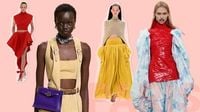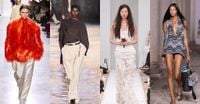Paris Fashion Week has long been the heartbeat of global style, and this year’s Spring/Summer 2026 collections—unveiled between September 30 and October 4, 2025—proved the city’s pulse is as strong and unpredictable as ever. From the storied halls of the Louvre to sun-drenched auditoriums and avant-garde runways, designers, models, and industry insiders converged to chart the next chapter in fashion. But as much as the catwalks dazzled with color, cut, and creativity, the real story was how both tradition and technology are rewriting the rules of what we’ll wear tomorrow.
According to The Associated Press, the week’s runway presentations featured a who’s who of fashion houses: Courreges, Issey Miyake, Stella McCartney, Louis Vuitton, Vivienne Westwood, and more. Each brought a distinctive vision to the Paris stage. Issey Miyake’s models glided in sculptural, fluid silhouettes, while Stella McCartney continued her eco-conscious crusade with plant-based alternatives to feathers and bold-shouldered suiting. Louis Vuitton, meanwhile, set the tone with a show inside the opulent Louvre, dazzling a front row packed with global celebrities.
But this season, it wasn’t just designers and editors dictating what’s next. As NPR reported on October 4, 2025, artificial intelligence (AI) is increasingly playing a starring role in forecasting trends. Paris-based company Heuritech, for example, successfully predicted dotted prints, flat-thong sandals, and the prominence of yellow—months before these looks hit the Paris runways. "Our models track everything from runway shows to social media," explained Noémie Voyer, fashion expertise lead at Heuritech. "We have a massive scale of data that allows our AI to detect early signals of trends—sometimes months before they become visible on the mainstream market." These predictions have already begun to trickle down, with dotted prints and sunny hues popping up in both high fashion and fast fashion alike.
The AI revolution isn’t just about spotting polka dots or the next hot color, though. Amy Sullivan, vice president of buying and private brands at Stitch Fix, told NPR that AI has streamlined decision-making for product design and inventory. "In the past, to answer that question, you either make a spot decision without really looking at it, or you're requesting samples from vendors overseas that could take weeks and cost a lot of money," Sullivan said. With AI, her team could visualize options instantly—recently choosing a blue stripe shirt over a red one for spring, based on data-driven insights. It’s a seismic shift that’s making fashion faster and more responsive than ever.
Still, the human touch remains essential. Francesca Muston, chief forecasting officer at WGSN, cautioned, "We can use AI to supercharge what we do, but you have to really start putting a lot of rigor and a lot of process into what you're doing." As she pointed out, viral trends on social media don’t always translate to real-world sales. The industry’s challenge is to balance entertainment with commerciality—making sure that what looks great on Instagram also flies off the shelves.
While technology buzzed behind the scenes, the runways themselves were a study in both continuity and reinvention. The Times spotlighted Alaia’s collection as a standout, with Belgian designer Pieter Mulier favoring evolution over revolution. Vibrant shades of violet and citrine punctuated Alaia’s signature blacks and reds, while macrame details and cocooning sheath dresses added a tactile, almost architectural dimension. The accessories, too, made waves—scarlet red suede handbags looked poised to become next season’s must-haves.
Maison Margiela, under the creative direction of Glenn Martens, leaned into the practical and contemporary, debuting a ready-to-wear line that balanced subversive details—like electrical-tape embellishments and embossed knitwear—with wearable classics. The show’s soundtrack, provided by the Orchestre à l’École (a youth orchestra), hinted at a focus on fashion’s future, not just its past.
Hermès, steered by Nadège Vanhée, played to its strengths, delivering what loyal fans crave: smooth shapes, elegant pencil skirts, and perfectly constructed leathers. Silk scarves—tied in myriad ways—and knee-length riding boots in chocolate brown and black anchored the collection. In a market where luxury is increasingly scrutinized, Hermès’ steady hand reassured its faithful following.
Victoria Beckham’s collection, meanwhile, mined her personal history for inspiration. As she told The Times, revisiting old videos from her youth—and seeing her teenage daughter Harper embrace her own style—sparked a playful, nostalgic energy. Oversized tailoring and slip dresses evoked the feeling of dressing up in someone else’s clothes. Beckham’s brand, which straddles both fashion and beauty, reported a 26% revenue increase in 2024 to £112.7 million, marking its fourth consecutive year of double-digit growth. Yet the label is still operating at a loss, with a £6.2 million loan advanced by shareholders this year to address “material uncertainties.” Even in the rarefied air of Paris, financial realities remain inescapable.
Elsewhere, the week was marked by notable debuts and bold statements. Jonathan Anderson made his much-anticipated debut at Dior, reimagining the house’s iconic New Look silhouette with a blend of hard tailoring and relaxed, contemporary separates. "It’s about having an empathy with Dior’s language, which has a part in the collective imagination," Anderson said backstage, "but then daring to put it all back in the box. Not to erase it, but to store it." His collection, which paired extravagantly cut jackets with denim skirts and outsize jeans, drew both praise and debate—exactly the kind of tension that keeps Paris Fashion Week relevant year after year.
Sarah Burton’s second collection for Givenchy showcased her mastery of tailoring—Naomi Campbell’s tuxedo look was a particular highlight—while also nodding to the house’s storied legacy with princess-worthy gowns. Loewe’s debut under Jack McCollough and Lazaro Hernandez brought a playful, nautical twist, and Carven’s Mark Thomas delivered wearable, subtly upgraded classics designed "for a real woman," as he put it backstage.
Saint Laurent opened the week with a showstopper beneath the Eiffel Tower, serving up oversized leather jackets, pencil skirts, and parachute-like evening gowns. Louis Vuitton, ever the master of spectacle, transformed its signature trunk shapes into baroque-inspired prints and paired them with streetwear flourishes and faux-fur-trimmed minis. The front rows glittered with stars—Madonna, Zendaya, Helen Mirren, and Robin Wright among them—reminding everyone that fashion is as much about the spectacle as the clothes themselves.
Of course, the industry’s gaze never strays far from the bottom line. As Fashionista noted in its October 4, 2025, roundup, the week’s buzz wasn’t limited to Paris. Milan’s trends, Jonathan Anderson’s Dior debut, and September editors’ picks all vied for attention, reflecting a fashion landscape that’s more global—and more interconnected—than ever before.
In the end, Paris Fashion Week 2025 was a study in contrasts: tradition and innovation, artistry and analytics, fantasy and financial reality. Whether guided by the seasoned eye of a creative director or the algorithmic predictions of AI, the city once again proved why it remains the world’s fashion capital. And as the last model exited the runway, one thing was clear—Paris isn’t just keeping up with the times; it’s setting the pace.

